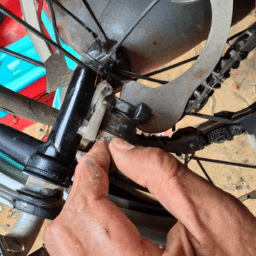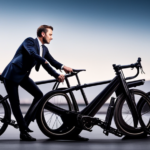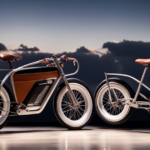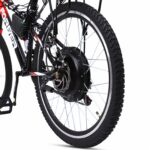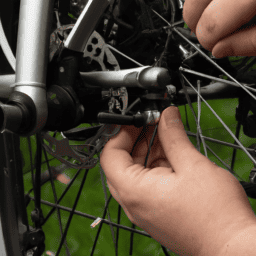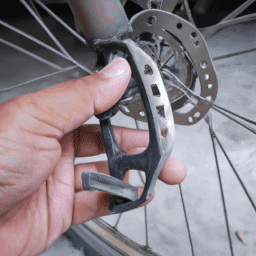Transforming a standard bicycle into an electric one may appear challenging, yet it becomes a straightforward procedure when equipped with the appropriate tools and gear.
Not only does converting a bike to electric make it easier to ride uphill or over long distances, but it’s also a cost-effective way to get an electric bike without breaking the bank.
In this article, I’ll guide you through the process of converting your bicycle into an electric bike. From removing the rear wheel and installing the motor to connecting the throttle and pedal assist system, I’ll cover all the steps you need to take to turn your regular bike into a powerful electric one.
So, grab your tools and let’s get started!
Key Takeaways
- Converting a regular bike to an electric bike is simple and cost-effective.
- Battery and controller selection are crucial for performance.
- There are different types of throttle controls and pedal assists to make cycling easier.
- Safety precautions and regular maintenance are important for optimal performance and efficiency.
Gather Your Tools and Equipment
You’re gonna need some basic tools and equipment, so grab your wrench, pliers, and wire cutters and let’s get started on turning your regular bicycle into an electrifying ride!
When it comes to tool selection, it’s important to make sure you have the right tools for the job. A socket wrench set, screwdrivers, and a pair of pliers are just a few of the tools you’ll need. And don’t forget about safety precautions! Wear gloves and eye protection to protect yourself from any potential accidents.
Once you have your tools and equipment ready, it’s time to get started on the conversion process. The first step is to remove the rear wheel and install the motor. This is where your wrench and pliers will come in handy. Make sure you follow the manufacturer’s instructions carefully and double-check everything before you start the motor.
With the right tools and a little bit of patience, you’ll have your electric bike up and running in no time!
Remove the Rear Wheel and Install the Motor
After removing the rear wheel, the next step is to select a suitable motor and replace the wheel. Choosing a motor that fits your bicycle and your needs is crucial to ensure a smooth and efficient ride. There are various types of motors available, such as hub motors, mid-drive motors, and friction motors.
Hub motors are the most popular and easiest to install. Once you’ve selected the motor, it’s time to replace the rear wheel with the motorized wheel. You may need to adjust the spacing of the dropouts to fit the motorized wheel. Make sure the wheel is aligned and tightened securely before moving on to the next step.
With the motor installed, you can now move on to installing the battery and controller for your electric bicycle.
Now that the motor’s installed, it’s time to power up your electric bicycle by installing the battery and controller.
Install the Battery and Controller
Now that the motor’s in place, let’s get the ball rolling with installing the battery and controller to bring your electric bike to life.
Choosing the right battery is crucial for your electric bike’s performance. You want to make sure that your battery has enough power and capacity to match your motor’s needs. The most common type of battery used for electric bikes is a lithium-ion battery. They’re lightweight, efficient, and have a long lifespan. You can choose to mount the battery on the frame or the rear rack of your bike. Remember to keep it away from water and excessive heat to prevent damage.
Programming the controller is just as important as choosing the right battery. The controller is the brain of your electric bike, and it controls the power output and speed. You can program the controller to match your riding style and preferences. You can adjust the throttle response, pedal assist levels, and maximum speed.
Make sure to read the instructions carefully and follow the manufacturer’s guidelines. Once the battery and controller are installed and programmed, you’re ready to connect the throttle and pedal assist system to complete your electric bike.
Connect the Throttle and Pedal Assist System
In this step of converting my bicycle into an electric bike, I’ll be connecting the throttle and pedal assist system. First, I’ll attach the throttle to the handlebars and connect it to the controller.
Then, I’ll install the pedal assist sensor and connect it to the controller as well. Finally, I’ll test the system to make sure both the throttle and pedal assist are functioning properly.
Attach the Throttle
First, you’ll want to attach the throttle to your handlebars to feel the rush of power at your fingertips. The throttle is the device that controls the speed of your electric bicycle. It’s important to choose the right type of throttle for your needs. There are two main types of throttles: thumb and twist.
The benefits of throttle control are that it gives you the ability to control your speed without having to pedal constantly, making it easier to ride up hills or over long distances. A thumb throttle is a small lever that you press with your thumb to increase or decrease your speed. A twist throttle is a rotating grip that you twist to control your speed. Both have their advantages and disadvantages, so it’s important to consider which one is right for you. The following table compares the two types of throttles:
| Thumb Throttle | Twist Throttle | |
|---|---|---|
| Control | Pressing | Twisting |
| Ease of use | Easy to use with gloves | Requires grip strength |
| Accuracy | Less precise | More precise |
| Safety | Thumb can slip off | Hand can get stuck |
| Price | Cheaper | More expensive |
Now that you have attached the throttle, it’s time to install the pedal assist system to get the most out of your electric bicycle.
Install the Pedal Assist System
To install the pedal assist system, you’ll need to follow these simple steps. First, choose the right pedal assist system for your bicycle. There are several options available, including mid-drive systems, hub motors, and bottom bracket sensors. Each has its own benefits and drawbacks.
Mid-drive systems are the most efficient, but they can be expensive. Hub motors are the easiest to install, but they can add a lot of weight to your bike. Bottom bracket sensors are the most responsive, but they can be difficult to install.
Once you’ve chosen the right pedal assist system, you can start reaping the benefits. Pedal assist can make cycling easier and more enjoyable, especially for longer rides or hilly terrain. It can also increase your average speed, allowing you to cover more ground in less time.
With the right system, you can choose how much assistance you want, so you can still get a workout while enjoying the benefits of an electric bike.
Now that you’ve installed the pedal assist system, it’s time to test the system and take it for a spin.
Test the System
Now it’s time to take your newly equipped electric bike for a spin and see how the pedal assist system performs! Before you hit the road, there are some important things to consider.
First, you need to perform a performance analysis of the system. This will help you understand how well the system is functioning and whether it needs any adjustments.
To perform a performance analysis, follow these steps:
- Start pedaling and observe how quickly the motor kicks in.
- Test the different levels of assist to see how they affect your pedaling effort.
- Take note of the battery life and how far you can travel on a single charge.
It’s also important to consider safety considerations when testing out your electric bike. Make sure you wear a helmet and other protective gear, and obey all traffic laws.
Once you’ve tested the system and ensured that it’s functioning properly, you can move on to fine-tuning your electric bike by making any necessary adjustments to the motor or battery.
Fine-Tune Your Electric Bike
Get ready to elevate your biking game by fine-tuning your electric bike for the ultimate riding experience. Maximizing efficiency and ensuring safety are the key factors in fine-tuning your electric bike. By doing so, you can make the most out of your biking experience and enjoy the benefits of an electric bike.
To start, let’s talk about maximizing efficiency. One way to do this is by adjusting the pedal assist levels of your bike. Pedal assist is the feature that makes your electric bike, well, electric. It amplifies the power of your pedaling, making it easier to climb hills, ride longer distances, and go faster. By adjusting the pedal assist levels, you can customize the amount of electric power you want to use, depending on your needs. This not only saves battery life but also helps you conserve energy while biking. Another way to maximize efficiency is by keeping your bike well-maintained. Regular check-ups on the battery, tires, and brakes can make a huge difference in the performance of your electric bike.
Now, let’s move on to safety precautions. While electric bikes are generally safe, it’s important to take extra precautions when riding one. First and foremost, always wear a helmet. This protects your head in case of an accident and can save your life. Secondly, make sure your bike has proper lighting and reflectors. This makes you more visible to other motorists and helps prevent accidents. Finally, follow the rules of the road. Just like any other vehicle, electric bikes must adhere to traffic laws, including stopping at red lights and stop signs. By following these safety precautions, you can enjoy your electric bike with peace of mind.
| Benefits | Emotions | Features | ||
|---|---|---|---|---|
| Eco-friendly | Happy | Battery-powered | ||
| Saves money on gas | Relieved | Pedal assist | ||
| Easy to use | Excited | Customizable pedal assist levels | ||
| Faster than traditional bikes | Empowered | Proper maintenance | ||
| Fun to ride | Thrilled | Proper safety precautions | Overall, electric bikes are a great option for those looking for a more sustainable, efficient, and enjoyable mode of transportation. |
Frequently Asked Questions
How much weight will the electric conversion add to my bicycle?
Calculating the weight of an electric conversion for a bicycle involves considering the chosen batteries. For my own conversion, I’ll be choosing a lightweight lithium-ion battery to minimize added weight.
Can any type of bicycle be converted into an electric bike?
When considering converting a bicycle into an electric bike, it is important to take into account factors such as battery options and motor power. Different types of bicycles may require different components for optimal conversion.
How long does it take to fully charge the battery?
The battery charging time for my electric bike is approximately 4-6 hours, depending on the battery’s capacity. The battery life expectancy is around 500-1000 charging cycles, but proper maintenance can extend its lifespan.
Will the installation of the motor affect the warranty of my bicycle?
The installation of an electric motor may potentially void the warranty of your bicycle. It is important to consider safety concerns and compatibility issues before making modifications. Be aware of any potential drawbacks and warranty implications.
Are there any specific laws or regulations I need to follow when riding an electric bike?
It’s important to follow laws and regulations when riding an electric bike. Pros include easier commuting and decreased environmental impact, but cons include limited range and high cost. Safety gear is essential for protection.
Conclusion
Well folks, congratulations! You’ve successfully converted your bicycle into an electric bike.
Now you can finally join the ranks of the elite electric bike riders and show off your fancy new ride to your friends. But before you hit the road, let’s take a moment to reflect on the journey we just went through.
First, we gathered our tools and equipment like a bunch of overeager beavers. Then we removed the rear wheel and installed the motor like a team of expert mechanics.
We installed the battery and controller like a couple of brain surgeons. Finally, we connected the throttle and pedal assist system like a pair of rocket scientists.
And after all that hard work, we fine-tuned our electric bike like a couple of perfectionists.
But let’s be real here, folks. Was it all worth it? Did we really need to spend all that time and effort just to turn a perfectly good bicycle into an electric monstrosity?
I mean, sure, it’s fun to go fast and feel the wind in your hair. But at what cost? We’ve destroyed the simplicity and elegance of the bicycle and replaced it with a bulky, complicated machine that requires constant maintenance and charging.
So go ahead, ride your electric bike with pride. But don’t forget the true joy of cycling lies in the simplicity of a good old-fashioned pedal-powered bicycle.
